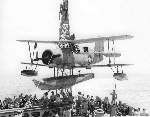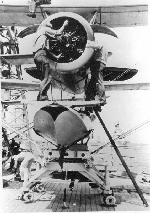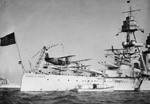| Click On Image For Full Size Image |
Size | Image Description | Contributed By And/Or Copyright |
|
|---|---|---|---|---|
 |
95k | The Curtiss SOC 'Seagull' was a noteworthy navy seaplane, designed as a replacement for the Vought O2V and O3V 'Corsair' floatplanes which were the Fleetís standard long range eyes for scouting and reconnaissance over the horizon, anti- submarine patrol and observation of the fall of gunfire from ship, through the early years of the development of radar till 1936. Competing with Vought and Douglas types, it was first flown in 1934 and won an initial contract for 135 aircraft. By 1940 there were 279 SOCís in service aboard ships in the Fleet. It served the Navy in four different versions as SOC-1, 2, 3,(of VCS-12 pictured aboard the light cruiser Denver (CL-58) 4, (pictured aboard the seaplane tender Tangier (AV-8) for repair work at Noumea, New Caledonia in May 1942) aboard every battleship and cruiser in the Fleet by 1940. Others were based at several naval stations around the country as the single main float could be replaced with wheels for land-based operation. During world war two several different camouflage schemes that used shades of blue and grey were applied to SOCís along with different styles of identification and markings in various locations on wings and fuselage. Cruisers could carry and service up to eight SOCís - four in a hanger with their wings folded and two, knocked-down (disassembled) spares and two more in 'ready' condition (ready for launch). Sometimes up to three aircraft would be carried atop catapults with their outboard wing panels folded back. The SOC required only 12 Ĺ ft. of storage space for its wings. During the war, only three or four aircraft were carried aboard. Curtiss won a contract to produce the SO3C 'Seamew', designed as a high speed scout aircraft to replace the venerable SOC as a medium powered Scout Observation type. Eight hundred aircraft were produced. However, it lacked performance and good handling qualities and was relegated to support roles. The SOC served on past its intended replacement until 1946. Specifications Crew: 2 - pilot and observer / radio operator. Span: 36ft. Length: 31ft.8in. Height: 14ft.1in. Wing Area: 348 sq. ft. Weight: Empty-3788 lbs. Gros.-5153 lbs. Max. Speed at 5000ft.: 153mph. Climb Rate: 5.9 min. to 5000ft. Service ceiling: 15,000ft. Range 846 miles (at cruise speed) Armament: two 100-lb. bombs, parachute flares, one fixed forward-firing 0.30-caliber gun in fuselage with 550 rounds of ammunition, and one flexibly-mounted 0.30 in the rear cockpit for the observerís use. Engine: P & W R-1340, 550 hp. Nine-foot diameter Curtiss propeller. |
All Photos courtesy of Pieter Bakels. | |
 |
42k | Repair at sea of an SOC mounted on a handling truck aboard an unidentified battleship. | Photo courtesy of Pieter Bakels. | |
 | 3.00k | Four SOC 'Seagull's' are perched on Pennsylvania's (BB-38) stern, 2 July 1939. | USN photo released to San Francisco Examiner for publication via Jim Geldert. Photo of SOC courtesy of Pieter Bakels. | |
| Back To US Battleship Construction Index | Back To The Main Photo Index | Back To The Battleship Photo Index Page |
This page is created by Pieter Bakels and Michael Mohl & maintained by Michael Mohl
All Pages © 1996 - 2025, by Paul R. Yarnall NavSource Naval History. All Rights Reserved.